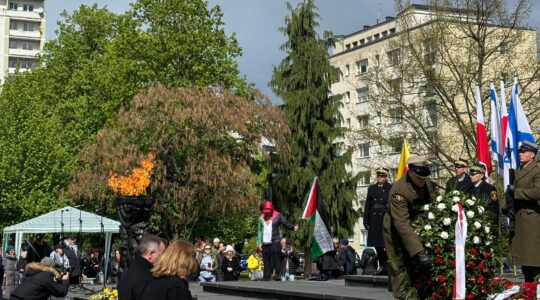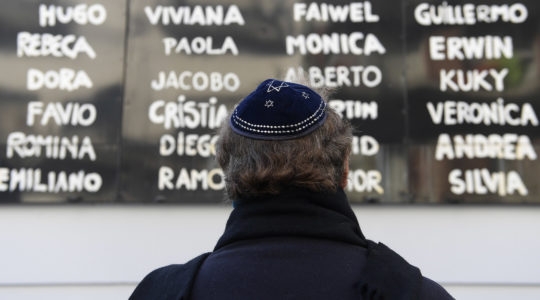VILNIUS, Lithuania (JTA) — A week after the Swiss referendum banning the construction of new mosque minarets in Switzerland, I flew to Vilnius, Lithuania, for a seminar that focused on the destruction of Jewish heritage in Lithuania during the Holocaust.
The timing was coincidental. And I realize that the Swiss voters who overwhelmingly approved the minaret ban were responding to scare tactics that raised the specter of an extremist Islamic takeover in their country.
Yet in a certain way, the Swiss vote Nov. 29 and the Lithuanian seminar were connected.
To me, the ban on minarets recalled centuries of restrictions on the size or prominence of synagogues. The Swiss ban is just the latest example of how governmental authorities target religious architecture as a means of limiting religious or cultural expression.
From early medieval times, synagogues in Europe often were forbidden to stand taller than Christian churches, and in many cases they were forbidden even to be outwardly visible. There were restrictions on synagogue architecture in Muslim countries, too.
This had nothing to do with zoning. It was a way for the dominant religion to demonstrate control over minority faiths, their practice and their adherents.
Opulently decorated synagogue sanctuaries often were hidden behind anonymous exteriors, and a number of synagogues had their floors and foundations laid much lower than street level so they wouldn’t be too tall. These included Vilnius’ own Great Synagogue, which was built in the early 17th century.
But religious architecture, too, often suffered much worse than restrictive regulation; it was targeted for destruction as a symbol of the people who prayed there.
“Beginning in the fourth century and continuing through the Middle Ages, and again in the 20th century, the ‘legal’ restriction and destruction of synagogues quickly led to the same policies applied against individuals, and then whole communities,” said Samuel Gruber, president of the International Survey of Jewish Monuments.
(Sam is one of the leading international authorities on Jewish heritage — and also my brother. We have worked together for many years on issues related to Jewish heritage preservation.)
During the Holocaust, the Nazis torched, blew up or desecrated hundreds of synagogues with the same fervor that they devoted to destroying Jewish communities, culture and civilization.
More recently, during the Yugoslav wars in the 1990s, Orthodox Serb, Catholic Croat and Muslim Bosniak fighters destroyed mosques, churches and other culturally significant places.
The term “warchitecture” was coined at the time to describe the deliberate destruction of architectural heritage as a tool of conflict or persecution.
The lasting impact of the Holocaust destruction of Jewish heritage was the focus of our seminar in Vilnius. It brought together representatives of various local institutions to discuss how the important Jewish contribution to the history and culture of Vilnius could most effectively be made known to today’s residents and visitors.
How to convey what was lost in the absence of tangible traces was a key part of the agenda.
“In a sense we are in search of the lost Vilnius,” said Deividas Matulionis, chancellor to Lithuania’s prime minister.
Vilnius, known in Yiddish as Vilna, was the so-called Jerusalem of the North. It was home in the 18th century to one of modern Judaism’s most influential intellectual and spiritual leaders, the so-called Vilna Gaon, Elijah ben Solomon Zalman.
Before World War II, about 100,000 Jews lived here. The Great Synagogue, standing in the heart of what is today’s postcard-perfect Old Town, was the most magnificent of more than 100 synagogues and prayer houses in the city.
The Vilnius Old Town today is on UNESCO’s roster of World Heritage Sites, but almost no physical traces of its Jewish past remain. There are a few street names, wall inscriptions and plaques, but that’s it.
The Great Synagogue itself, and the teeming Jewish quarter around it, was bombed during World War II and its ruins were razed by the Soviets in the 1950s. A kindergarten was built on the site.
Controversy has raged for years over what to do with the old Jewish quarter.
One multimillion-dollar plan, promoted by a Jewish member of Parliament and activist, Emanuelis Zingeris, called for sites, including the Great synagogue, to be rebuilt. The plan was approved but never really got off the ground due to financial considerations and opposition from within the 5,000-member Jewish community.
Complicating matters is Lithuanian society’s ambivalence about its past. Local nationalists regard the Nazis as liberators and the postwar Soviet government as an occupier, and anti-Nazi activity gets conflated with Soviet oppression. The Genocide Victims Museum in Vilnius is mainly about the Soviet persecution of Lithuanians between 1940 and 1991.
Local Lithuanians collaborated with Nazis to help kill about 90 percent of the 250,000 Jews who lived in Lithuania before the war. For Holocaust survivors, the Soviets were liberators before they became an occupying power.
The destruction of nearly all traces of Jewish historic presence in Vilnius left a gaping hole that has yet to be filled.
I know it’s a very long way from a ban on new minarets to the much more drastic measures that led to this state of affairs. But as my brother Sam put it, “Restricting specific types of religious or cultural expression — especially when such restrictions are deliberate exceptions to existing building, zoning, health and safety codes — is discriminatory.”
It is, he said, “an act of denigration of cultural custom and, by extension, of the people who cherish, or the religion that requires, those very customs.”
(Ruth Ellen Gruber’s books include “National Geographic Jewish Heritage Travel: A Guide to Eastern Europe,” “Letters from Europe (and Elsewhere),” and “Virtually Jewish: Reinventing Jewish Culture in Europe.” She blogs on Jewish heritage issues at jewish-heritage-travel.blogspot.com.)





